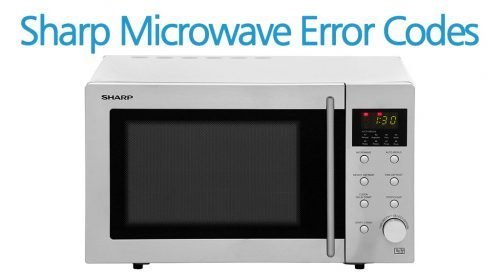
Let’s break it down. Error codes, like F1 on your Sharp microwave, are a bit like your car’s check engine light. It’s a warning signal, indicating that something under the hood isn’t quite right. Maybe it’s a minor issue that can be easily fixed, or perhaps it’s a sign of something more serious that could worsen over time. Either way, ignoring it could lead to bigger problems down the line and could even mean saying goodbye to your trusty microwave sooner than expected. So, what’s the real story behind this error code? And more importantly, what should you do about it?
Understanding the F1 Error Code
When it comes to modern appliances, they’ve got brains of their own – a little like having a mini-computer right in your kitchen. The F1 error code specifically on a Sharp microwave is like its way of waving a red flag. In essence, the F1 code usually indicates a problem with the microwave’s touchpad or control board. Imagine the control board as the brain of your microwave; when it encounters issues, it might struggle to process commands correctly.
Think of this situation as having a navigation system that suddenly starts giving wrong directions. While you might get by for a bit, continuing to ignore these inaccurate signals could lead you astray eventually. In practical terms, an unresolved F1 error might cause your microwave to stop working altogether or start behaving unpredictably, like refusing to start or shutting down midway through cooking.
So, what’s triggering this error? It varies, but often, prolonged usage or power surges are the culprits. Over time, the control panel can wear out, much like an old pair of shoes that develop holes after miles of walking. And just like you wouldn’t continue wearing holey shoes on a rainy day, it’s best not to ignore the signs your microwave is giving you.
Steps to Address the Error
So, you’ve decided not to ignore the F1 error. Great choice! Now, where do you start? First things first, a simple reset might do the trick. Unplug your microwave for a few minutes. It’s like giving it a small nap to reset its system. After that, plug it back in and see if the error persists. Sometimes, just like a computer needing a reboot, this can clear minor glitches.
If resetting doesn’t help, it might be time to dive a bit deeper – don’t worry, you don’t need to be a tech whiz for this. Carefully inspect the touchpad. Is it sticky or unresponsive? Residue buildup from cooking can interfere with the touchpad’s functionality. Gently clean it using a soft cloth with some mild detergent. Imagine it’s like cleaning your glasses; you want them clear without smudges for optimum performance.
But here’s the deal: If the error continues after these steps, the issue might be more internal, possibly requiring professional help. Think of it as calling a specialist when your car has a persistent issue. It’s better to fix it properly than to let a small problem escalate.
Going Beyond: Preventative Measures
Now that you’ve tackled the error, let’s look at how to prevent it from popping up again. Regular maintenance is key. Much like how you wouldn’t skip an oil change for your car, keeping your microwave in check can extend its lifespan. Periodically clean the interior and exterior, including the vents, to prevent dust and moisture buildup.
Consider investing in a surge protector. You know how storms can mess with electricity? Sudden power surges can wreak havoc on your microwave’s electronic components, leading to errors like F1. A surge protector acts as a shield, guarding your appliance against electrical spikes.
Lastly, use your microwave responsibly. Avoid slamming the door or pressing the buttons too hard, and ensure correct microwave-safe containers are used. Treat it kindly, and it’ll reward you with years of faithful service.
In conclusion, while that F1 error code might seem daunting at first, approaching it step-by-step can resolve the issue effectively. By addressing it promptly and taking preventative measures, you’re ensuring that your Sharp microwave remains a reliable helper in your kitchen adventures. And remember, it’s always worthwhile to pay attention to the signals your appliances send – they’re helping you keep everything running smoothly.